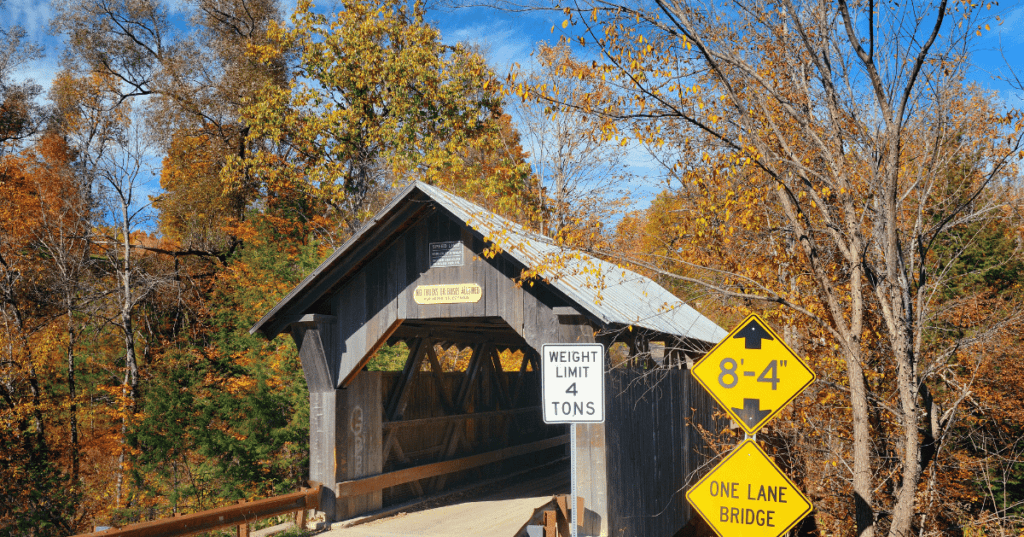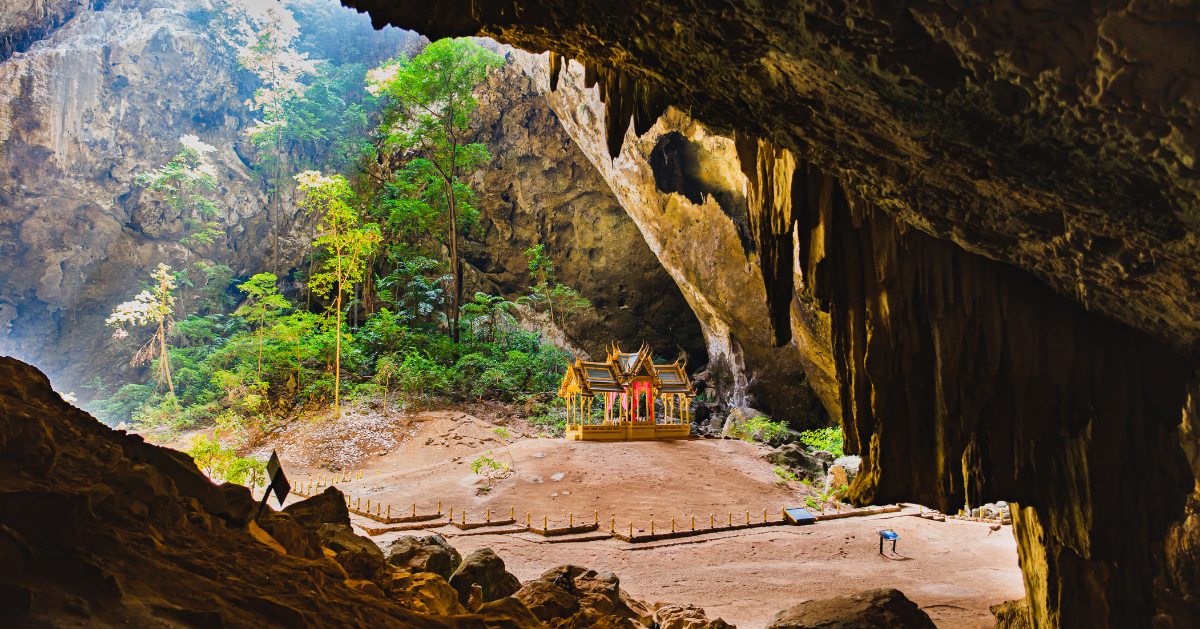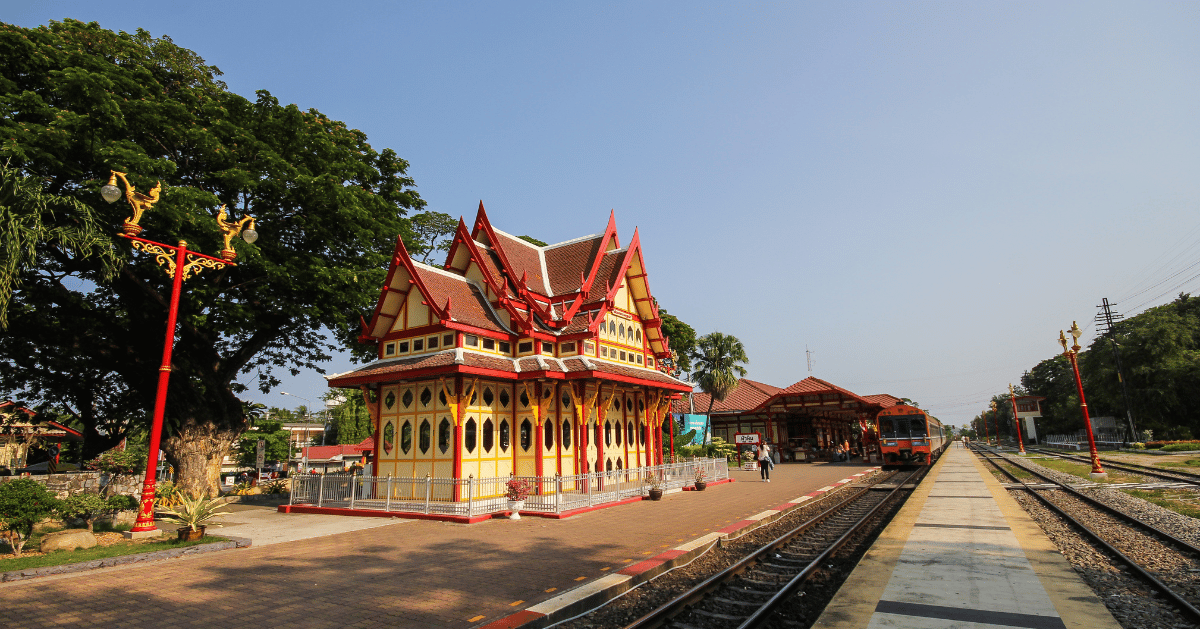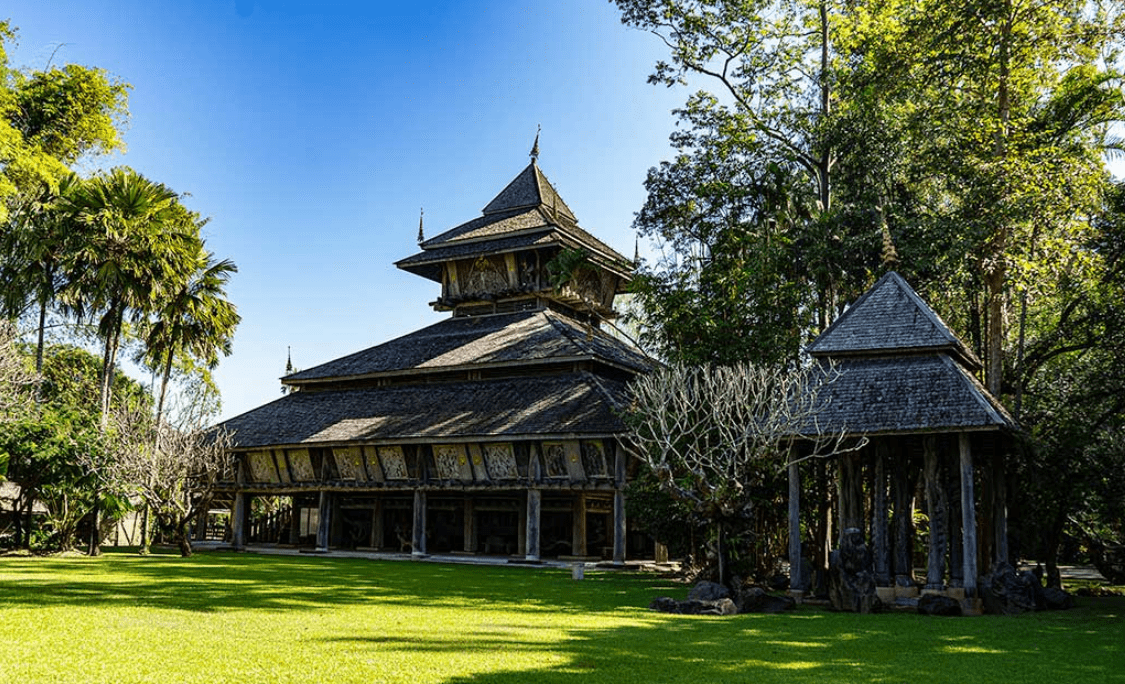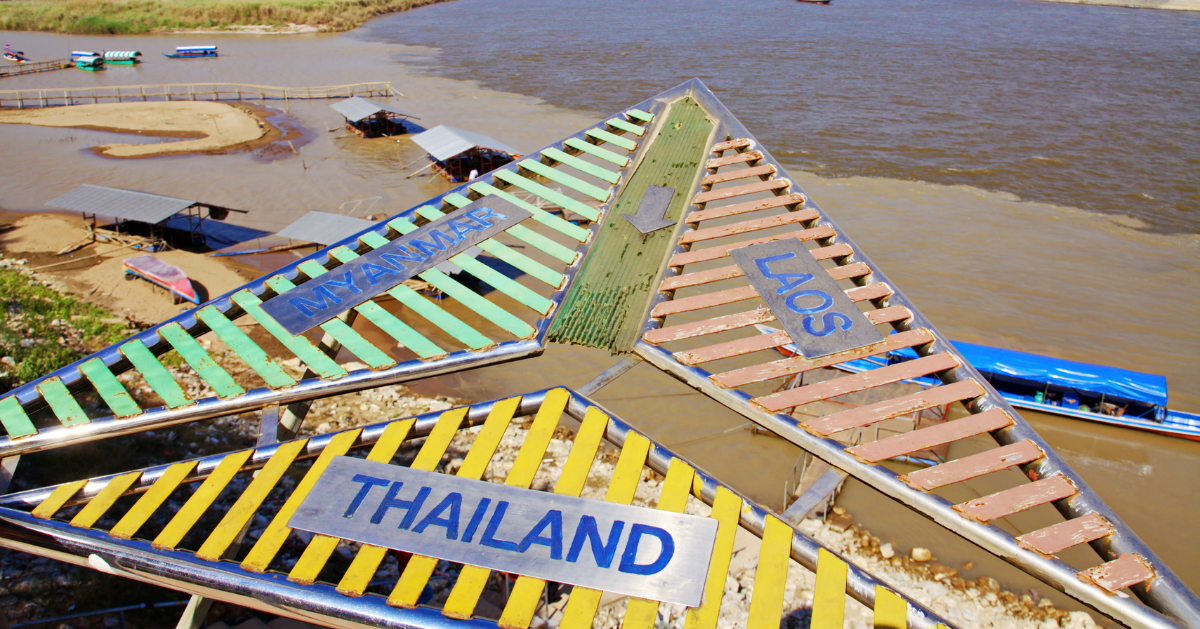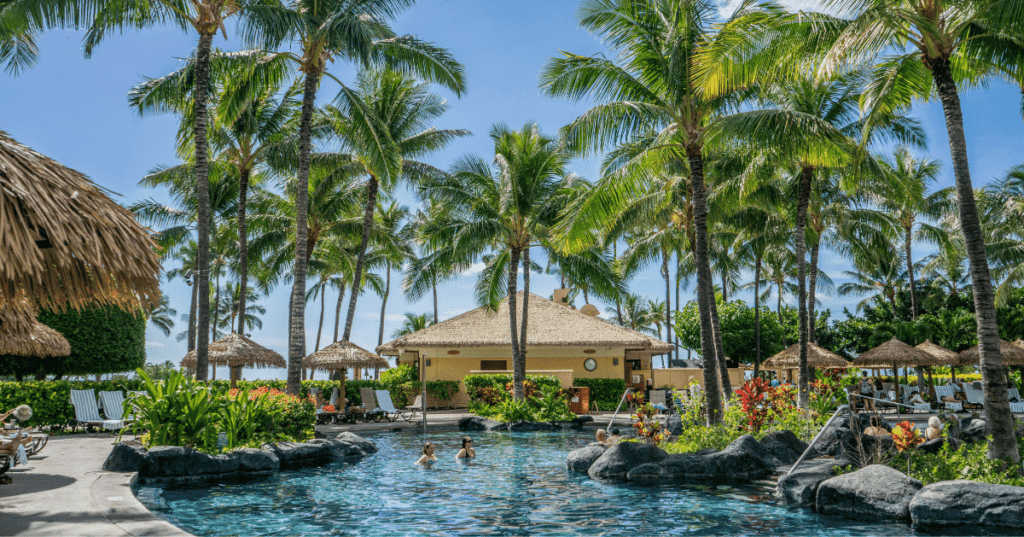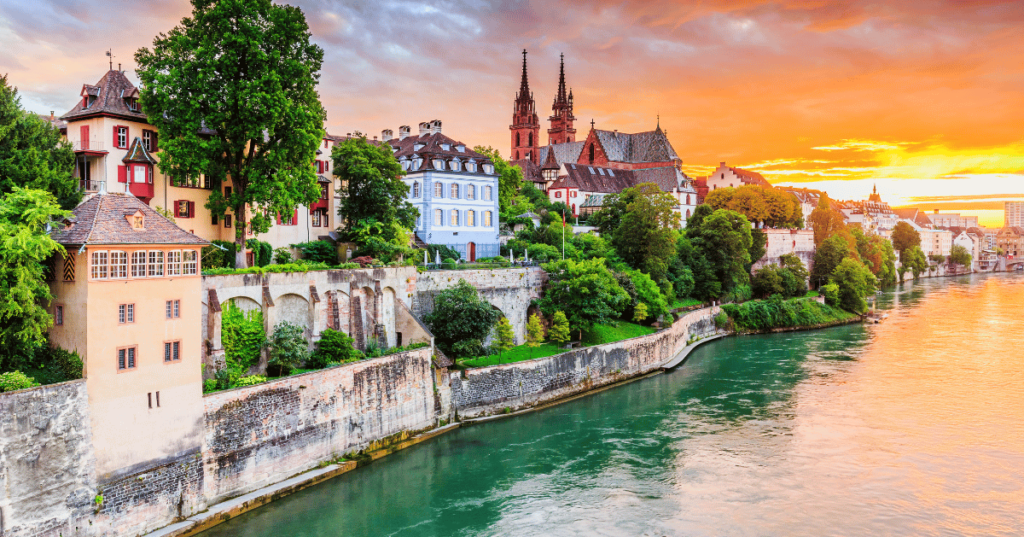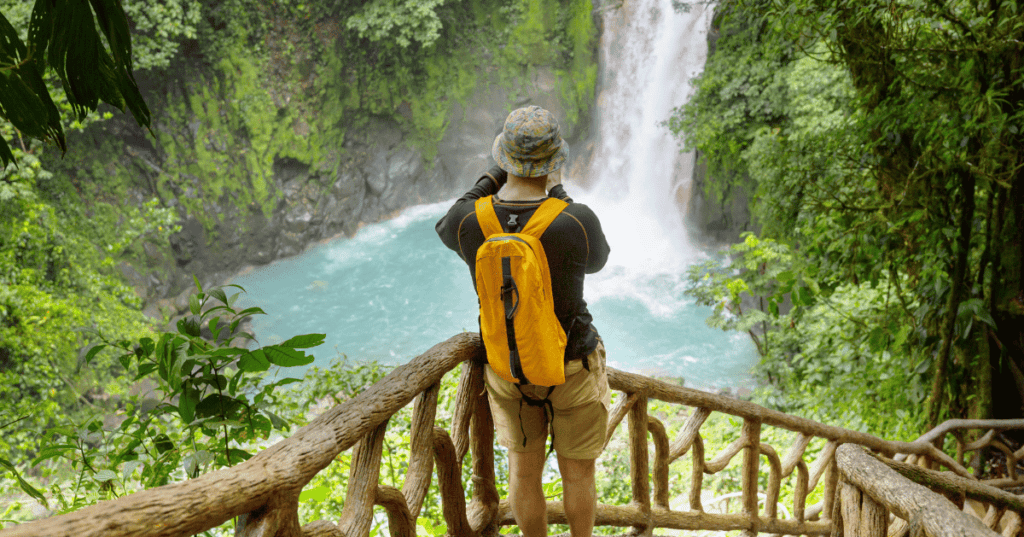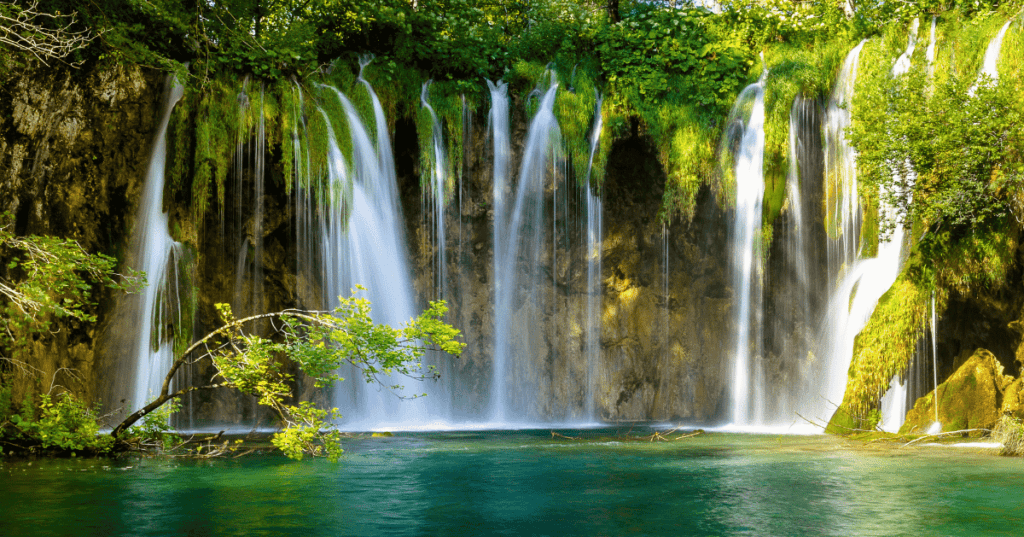I just returned from an incredible trip To Vermont where I have seen most beautiful castles, Amazing places and most of all i loved the covered bridges.
This guide will be dedicated to the Beautiful Covered Bridges in Vermont and I’m so excited to share my discoveries with you. These Covered bridges will take you back to 1820. Vermont had over 600 bridges! It’s amazing to think Vermont has the highest number of covered bridges per square mile in the U.S.
Today, over 100 of these iconic structures are still standing and open for us to visit and explore. But, of course you cannot visit all bridges in a limited time so, In this post, I’m going to show you the 12 best covered bridges in Vermont. I’ve listed my top picks first.
So, let’s dive in and discover these charming bridges together. These bridges are a must-see whether you’re into photography, history, or just enjoying a scenic drive. Let’s start our journey!
How to Visit Covered Bridges in Vermont?
There are almost 100 covered bridges in Vermont that are still open for tourists. But, unfortunately you cannot visit all of them in a short trip. But here’s how to make the most of your time in the Green Mountain State.
Start by deciding if you want to explore the most beautiful covered bridges across Vermont or if you’re concentrating on a specific area. Places like Woodstock or Stowe offer a great opportunity to discover several picturesque bridges.
If you are on a tight schedule, I’d suggest considering the Mad Valley Loop. It’s a fantastic way to see a bunch of these bridges in just one day, giving you a taste of Vermont’s rich history and stunning scenery.
Remember, some of these routes might take you through lesser-known paths, so be prepared for a bit of off-road adventure. Depending on the weather, especially in the more forested areas, having a 4×4 could make your journey smoother and more enjoyable.
The Most Beautiful Covered Bridges In Vermont
During my Vermont road trip, I did a proper research and and visited most of the covered bridges in Vermont. So, I have picked 12 out of them so you don’t have to go through the hustle. Here are the 12 most covered bridges in Vermont:
#1. Warren Covered Bridge
First, check out the Warren Covered Bridge on your Vermont tour. It is located in Warren on Covered Bridge Road, this historical bridge crosses the Mad River and is a classic example of Vermont’s architectural heritage.
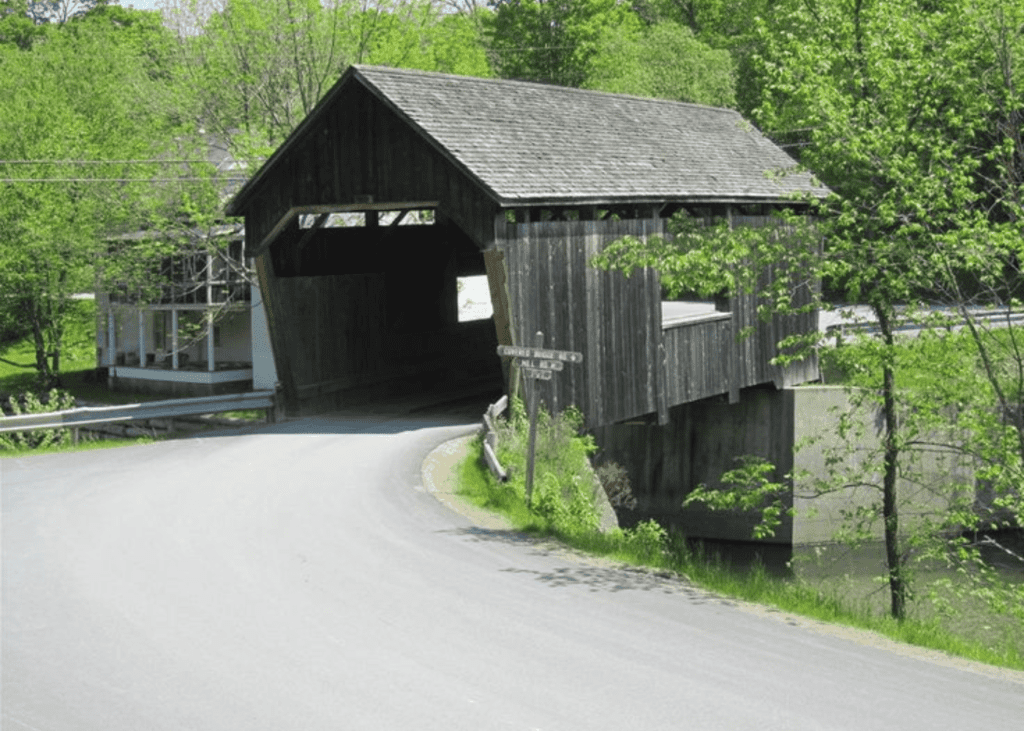
Warren covered bridge was built between 1879 and 1880 by Walter Bagley, its queen post truss design is both simple and functional, unique for being covered inside and out. The bridge’s asymmetrical portals, especially the overhanging gable roof on one side, add a distinctive charm.
Warren covered bridge is listed on the National Register of Historic Places in 1974, the bridge has undergone several restorations, including significant rehabilitation in 2000. Despite damage from Hurricane Irene in 2011, it remains open for both vehicle and pedestrian traffic.
It is easily accessible near the intersection of Town Hwy. 4 and Rt. 100, the Warren Covered Bridge is a must-visit for its historical significance and picturesque setting. Be cautious of cars when crossing on foot.
#2. Slaughterhouse Covered Bridge
Don’t miss the Slaughterhouse Covered Bridge when you’re in Northfield, Vermont. It was built in 1872 and it is one of Northfield’s five 19th-century covered bridges, spanning the Dog River and showcasing Vermont’s rich heritage in bridge construction.
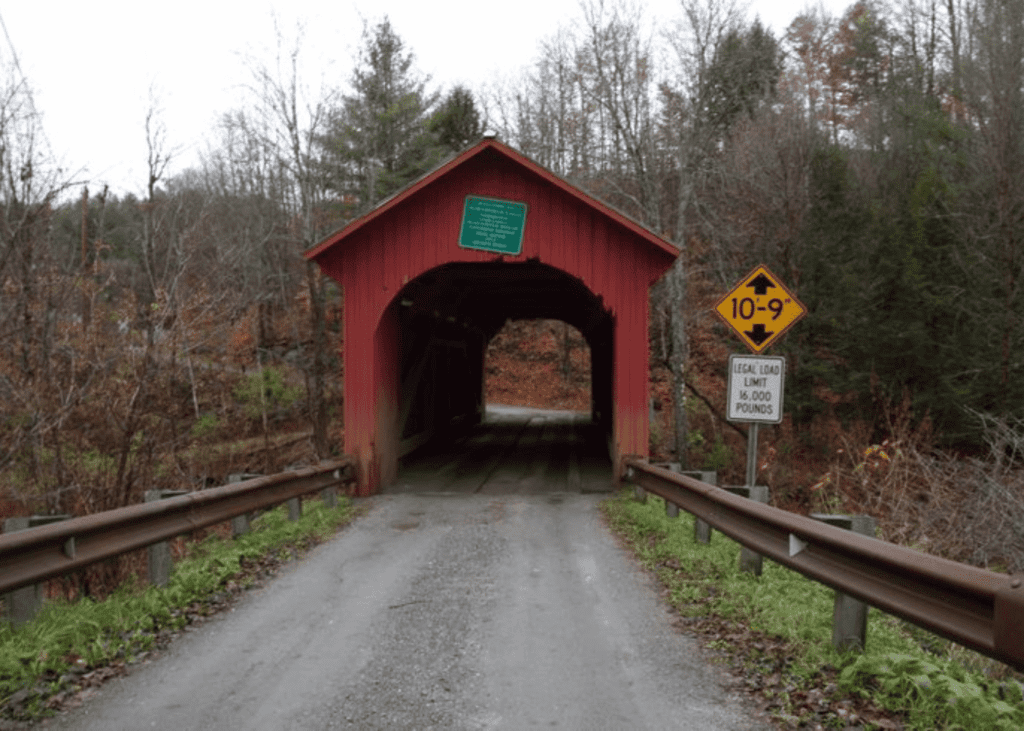
Slaughterhouse Covered Bridge was named after a nearby business, it’s a fine example of 19th-century engineering. The bridge boasts a single-span Queen post truss design, resting on stone abutments.
Despite its age, the bridge accommodates modern needs with an 8-ton weight limit, hinting at a possible 20th-century reinforcement.
Slaughterhouse covered bridge is listed on the National Register of Historic Places since 1974, the Slaughterhouse Covered Bridge is perfect for history buffs and nature lovers, it offers a peek into Vermont’s past wrapped in a serene, picturesque setting. Be sure to add it to your Vermont bridge exploration list!
#3. Gifford Covered Bridge
The Gifford Covered Bridge is also known as the C.K. Smith Covered Bridge Vermont. This historic bridge, spanning the Second Branch of the White River on Hyde Road, was listed on the National Register of Historic Places in 1974.
The bridge is resting on concrete abutments and it is notable for its King post truss reaching only halfway up – a result of initially being built uncovered and then enclosed by a post-and-beam structure around 1904.
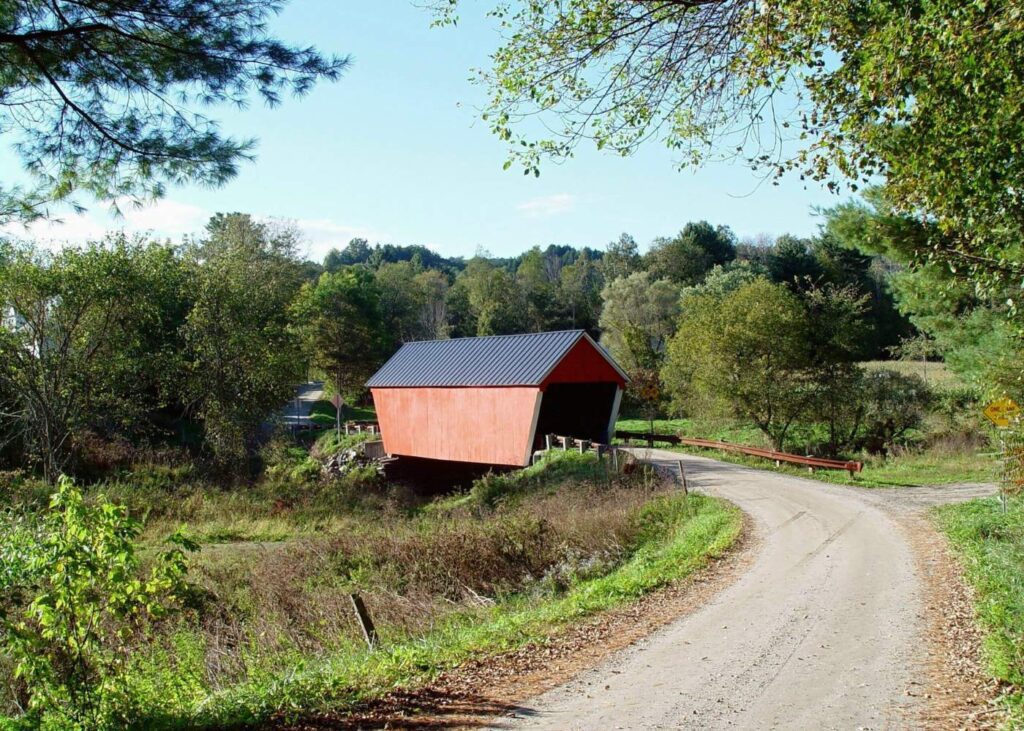
Recently the Gifford Covered Bridge has undergone refurbishments, including a striking red repaint, adding to its picturesque charm against the Vermont landscape. To support its double-truss design, steel beams and fresh lumber braces were added, enhancing its structural integrity while preserving its historical essence.
Visiting the Gifford Covered Bridge offers a journey into the past and a showcase of early American engineering. While it’s a beautiful sight for tourists, it’s also a testament to the ingenuity and adaptability of bridge design through the years. Make sure to include it in your Vermont covered bridge adventure!
#.4 Northfield Falls Covered Bridge
Next on your Vermont bridge tour is the Northfield Falls Covered Bridge, also known as the Station Covered Bridge. It was built in 1872 and crossing the Dog River, it’s a historical gem and part of a trio of bridges in the town.
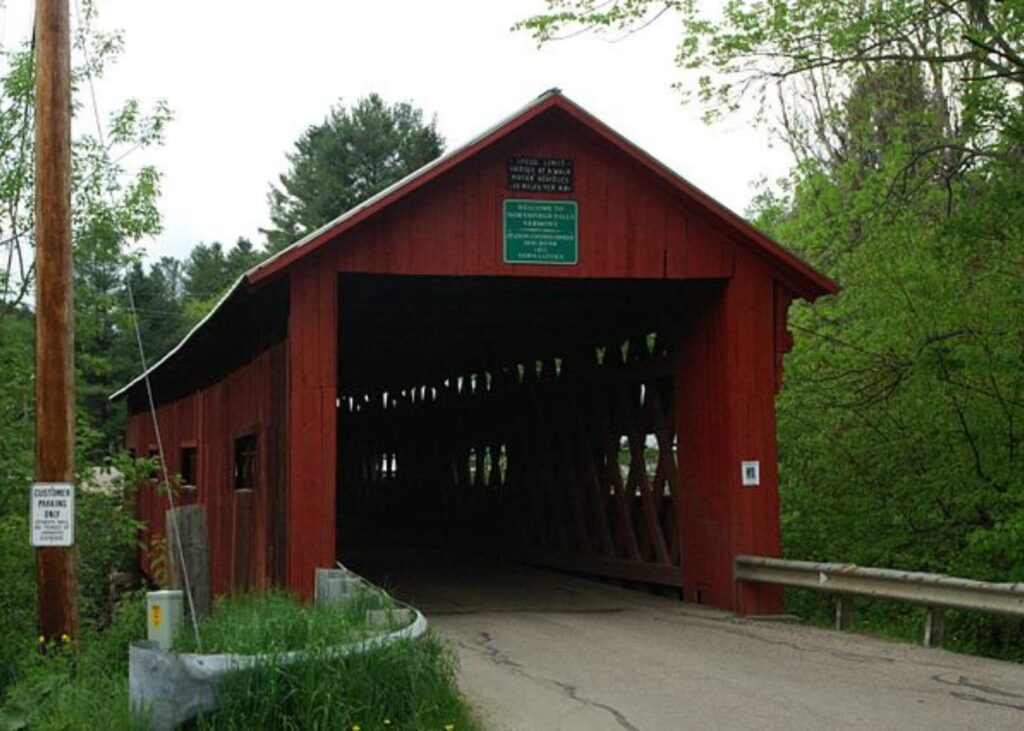
Northfield falls covered bridge is located in the village of Northfield Falls, just west of Vermont Route 12, this bridge is special because you can see another covered bridge from it, the Lower Cox Brook Covered Bridge. It’s a favorite spot for both visitors and photographers.
To keep it strong, the bridge was reinforced in 1963 with steel I-beams and concrete-faced abutments. It’s the longest bridge in Northfield and stands out for its Town lattice truss design, typical of early timber bridges.
It is a unique location and historical importance make it a must-visit for those exploring Vermont’s covered bridges.
#.5 Waitsfield Covered Bridge (Great Eddy Covered Bridge)
Next visit the Waitsfield Covered Bridge, also known as the Great Eddy or Big Eddy Covered Bridge, in Waitsfield, Vermont. This wooden bridge was built in 1833 over the Mad River on Bridge Street and it is one of Vermont’s oldest. It’s recognized for its historical value and is listed on the National Register of Historic Places.
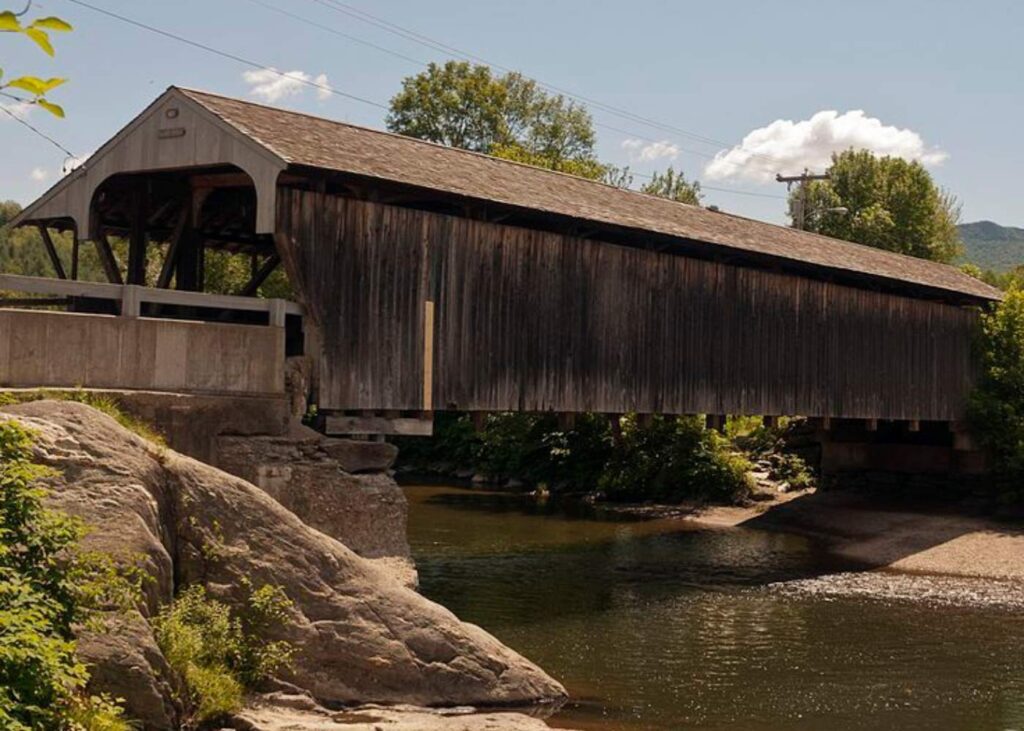
Waitsfield covered bridge is situated near the center of Waitsfield, the bridge is known for its Burr truss structure, the longest single-span of this type in the state. It’s been strengthened over time and features a metal roof with a walkway on one side, offering a great view of the river. Only the Pulp Mill Covered Bridge in Middlebury is older in Vermont.
The bridge has been repaired several times, including in 1973, 1989, 1992, and 2001, to keep it in good shape for all the traffic it gets. A unique part of its story is the 2016 installation of a no-diving sign, after a local board member spotted kids jumping off the bridge.
The Great Eddy Covered Bridge is a key part of the Waitsfield Historic District. It’s still used for transport and is easy to access on Bridge Street. Visiting it lets you see an important part of Vermont’s history and the beauty of early American covered bridges.
#6. Gold Brook Covered Bridge (Emily’s Bridge)
The Gold Brook Covered Bridge is also known as Emily’s Bridge and it is a unique wooden bridge in Stowe, Vermont. It was built in 1844 over Gold Brook. Gold Brook Covered Bridge is notable for its wooden Howe trusses, a rare feature for Vermont’s 19th-century bridges. It’s listed on the National Register of Historic Places.
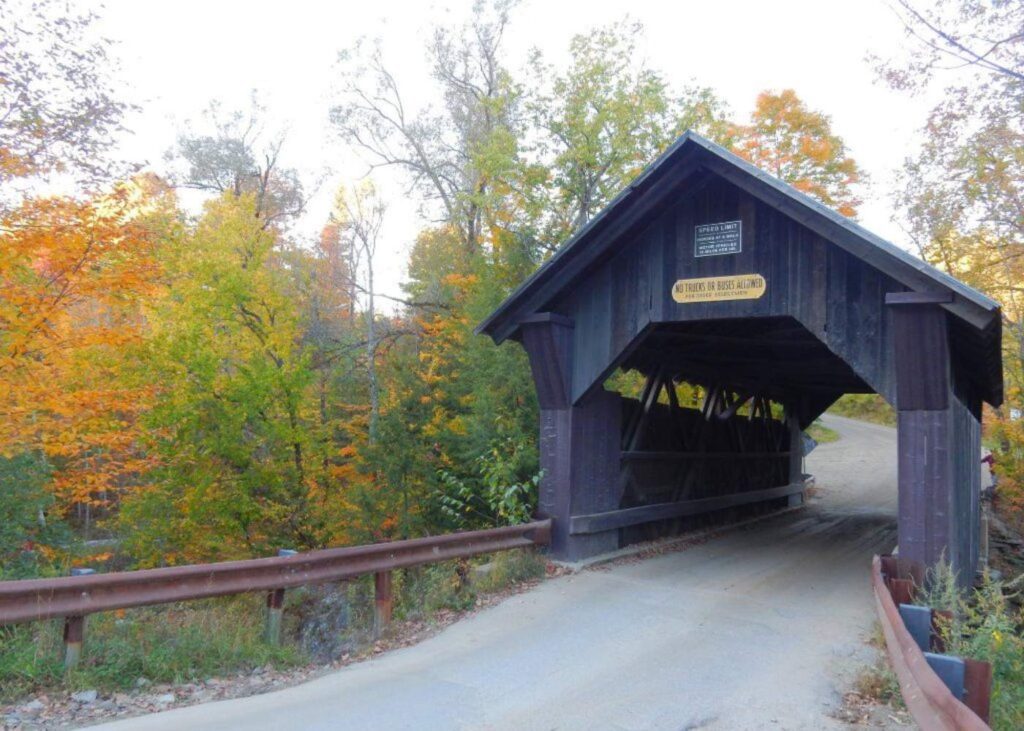
This bridge is 48.5 feet long and 17 feet wide, with a 13.5-foot wide road. It sits on stone abutments, has a metal gabled roof, and vertical board siding with an open strip at the top. Its wooden deck adds to its old-time feel. The bridge is an excellent example of early Howe truss construction, pioneered in 1840.
Now the Mysterious part of the bridge is the ghost story about Emily, a heartbroken young woman from the 1850s. The tale says Emily’s ghost haunts the bridge.
The Gold Brook Covered Bridge is a must-see for its historical and architectural significance, and for those intrigued by local myths and legends. It’s a great spot to experience Vermont’s history and a bit of mystery.
#7. Giles W. Dewey Memorial Bridge
In Stowe, Vermont, the Giles W. Dewey Memorial Bridge is a special tribute to Giles W. Dewey, a well-known local farmer, leader, and politician who died in 2000.
This bridge is near downtown Stowe, replaced an older one from 1916. What makes it unique is its pedestrian-only section, with an open side that offers a beautiful view of Stowe.
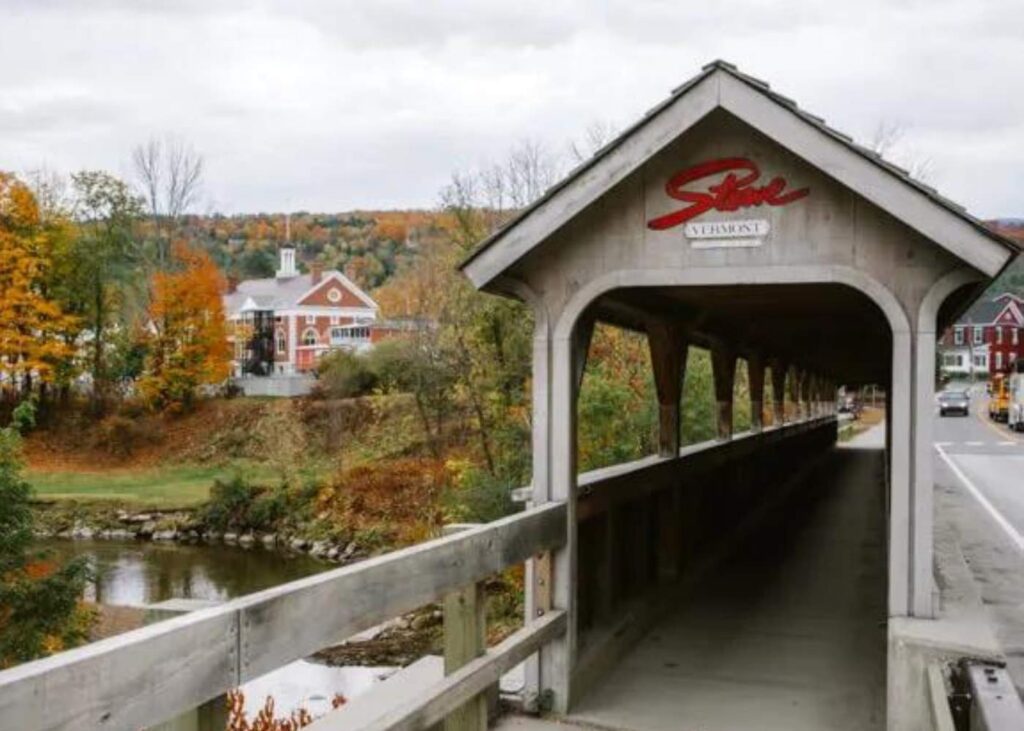
The bridge is both useful and an important part of the community, honoring Giles W. Dewey. It’s close to downtown, making it easy for people to visit and enjoy a scenic walk. The bridge shows Stowe’s dedication to remembering its history and influential residents.
While there’s not much detailed info on its construction, the Giles W. Dewey Memorial Bridge is valued for its dedication to a local figure and the lovely scenery it brings to the area. It’s a symbol of the personal stories and history that are part of local landmarks.
#8. Scribner Covered Bridge (Mudgett Covered Bridge)
The Scribner Covered Bridge, also known as Mudgett Covered Bridge, is a historic bridge in Johnson, Vermont. It crosses the Gihon River and is on the National Register of Historic Places. This bridge is special because it was first built open and then later covered.
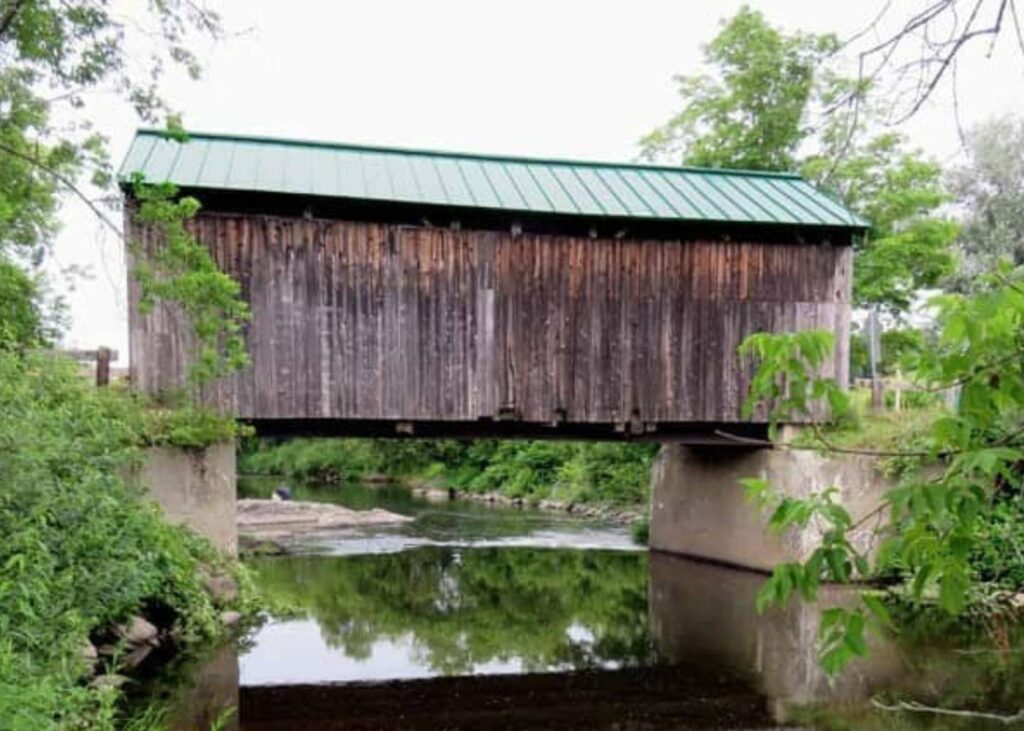
It’s in a quiet, rural area and is 48 feet long and 17.5 feet wide, just right for one lane of traffic. The bridge has a metal roof and vertical board sides. It sits on concrete bases made in 1960.
The details about when and who built the bridge are not clear. It was likely an open bridge first, based on its design. In 1960, it was strengthened with steel beams under the road part.
The Scribner Covered Bridge shows how Vermont’s bridges have been kept up and changed over time. It’s an important part of the area’s history and a beautiful spot in Johnson.
#9. Power House Covered Bridge
Next visit the Power House Covered Bridge in Johnson, Vermont. It’s an old bridge from 1872 that goes over the Gihon River. This bridge is important historically and is on the National Register of Historic Places.

The bridge is 73 feet long and 19 feet wide, perfect for one-way traffic. It has a strong stone base with concrete, a metal roof, and vertical sides.
It’s named after a nearby water-power building on the river. It used to be called the School Street Bridge, linking School Street to what is now VT Route 100C.
In 2001, the bridge collapsed because of heavy snow, but the town quickly decided to rebuild it. The new bridge was built by Blow and Cote of Morrisville, VT, and finished in 2002.
Seeing the Power House Covered Bridge is a great way to connect with Vermont’s history and see how the community works to preserve its heritage.
#10. Pulp Mill Covered Bridge
The Pulp Mill Covered Bridge is also known as the Paper Mill Covered Bridge. Pulp Mill Covered Bridge is a special historical bridge in Vermont. It goes over Otter Creek between Middlebury and Weybridge on Seymour Street and is on the National Register of Historic Places.
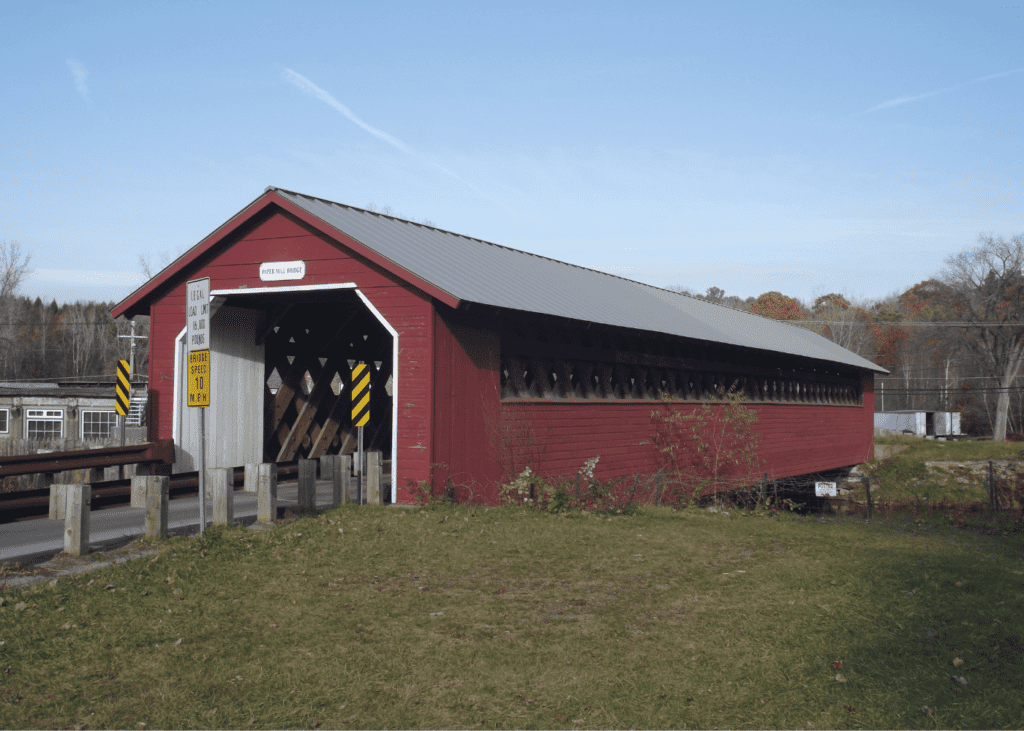
It was built in 1853, this bridge is has two lanes. It’s one of just two bridges like this in Vermont and has a Burr arch design.
This bridge has been around since 1820, which makes it one of Vermont’s oldest covered bridge in Vermont. It’s 195 feet long over Otter Creek. Even though it has two lanes, cars take turns going one way at a time.
The bridge had a big fix-up recently to keep it safe and keep its old look. Add Pulp Mill Covered Bridge in your bucket list if you are planning to see the beautiful covered bridges in Vermont.
#11. Quechee Covered Bridge
The Quechee Covered Bridge is a well-known and scenic bridge in Quechee, Vermont. It’s located at Quechee Falls Park, near US 4 between Woodstock and White River Junction. The bridge was built in 1970 over the Ottauquechee River and it was rebuilt after the damage from Tropical Storm Irene in 2011.
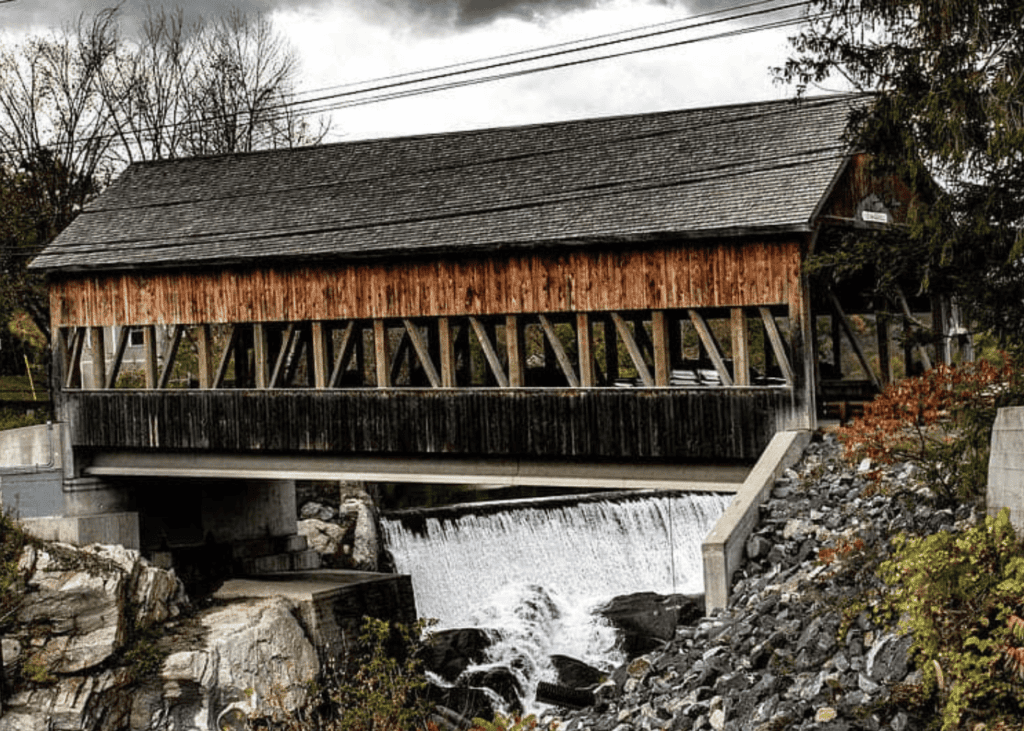
The bridge is part of Quechee State Park and offers great views. It’s a steel bridge with two lanes for cars and a walkway for pedestrians. The bridge is not just practical but also adds beauty to the area with its rocky gorge surroundings.
After the 2011 storm, the original bridge was replaced with a stronger one. This spot is a mix of beauty, history, and a sign of the community’s resilience. It’s a must-visit for its stunning views and as a highlight among Vermont’s covered bridges.
#12. Taftsville Covered Bridge
The last name on our list is “The Taftsville Covered Bridge,” and it is one of the oldest bridges in the state and the country. Taftsville covered bridge was built in 1836. It crosses the Ottauquechee River with a special two-span design.
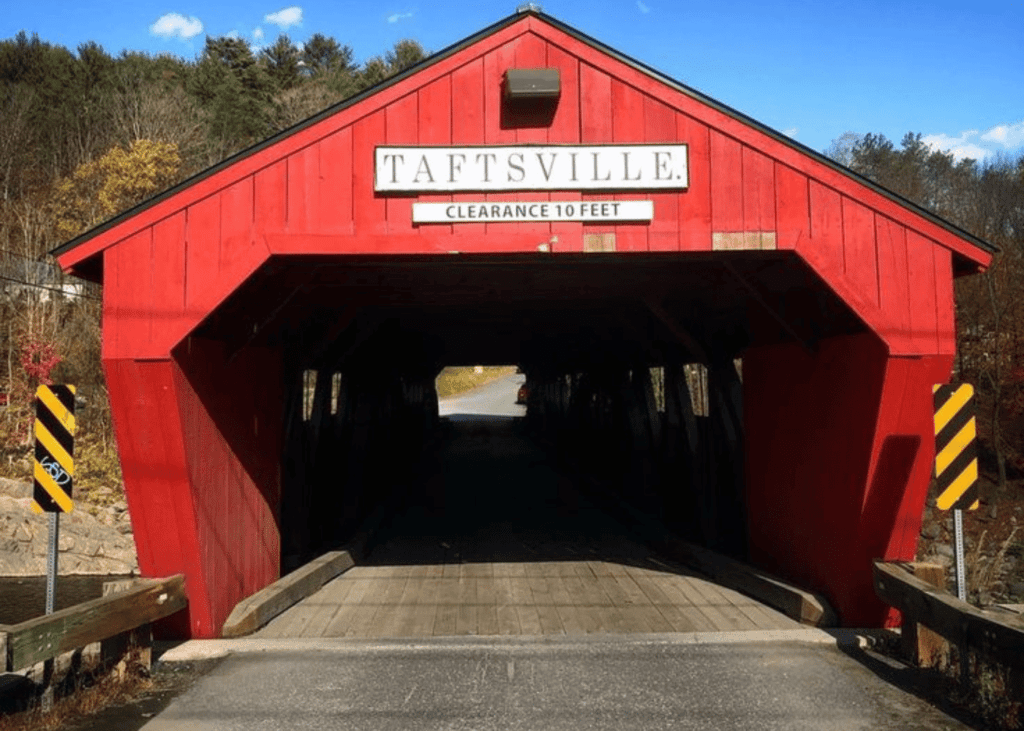
Taftsville bridge is made of timber by Salmond Emmons III. It looks great with its kingpost trusses and arches. It’s on the National Register of Historic Places since 1973 and has been fixed up a few times.
The area around the bridge is really pretty, with a dam, waterfall, and old mill site. It’s a great place for pictures.
At 189 feet long, it’s the second-longest covered bridge in Vermont. It was key for travel between Woodstock and Quechee, helping the Taftsville area grow.
Visiting this bridge lets you see a big part of Vermont’s history and natural beauty. It’s a perfect spot to feel like you’re stepping back in time.
My Final Words About Covered Bridges in Vermont
And there You have the most beautiful covered bridges in Vermont. Vermont, often celebrated for its delicious maple syrup and the famous Ben and Jerry’s ice cream, has a lesser-known but equally enchanting charm in these covered bridges.
With over 100 of these structures, Vermont not only captures the essence of historical architecture but also stands out as the state with the most covered bridges per square mile in the whole of the United States.
So, as we have explored some amazing bridges, the covered bridges are a journey into the heart of New England’s history and beauty. If you’re planning your dream travel destinations list, let Vermont’s covered bridges be a top choice.
It’s a unique, tranquil experience that’s waiting for you, promising stories, history, and beauty in equal measure. Trust me, a visit to Vermont’s covered bridges is an adventure you won’t forget!
In case you have missed my recent blogs, do check them below.
6 Best golf courses in Hua Hin, Thailand
Hua Hin is a must-visit if you’re planning a golf trip in Thailand. This charming coastal town is one of…
Cultural Riches of Chiang Rai: Mae Fah Luang Art and Cultural Park
Introduction to Mae Fah Luang Art and Cultural Park Mae Fah Luang Art and Cultural Park is a beautiful spot in…
FAQs About Vermont’s Covered Bridges
Why are covered bridges so common in Vermont?
Covered bridges are part of Vermont’s cultural heritage. They were primarily covered to protect their wooden structures from the elements, extending their lifespan.
Can you still drive through Vermont’s covered bridges?
Yes, many of Vermont’s covered bridges are still in use and can support vehicular traffic. However, it’s important to check specific bridge guidelines as some may only be restricted to pedestrian use.
Are there guided tours for Vermont’s covered bridges?
Yes, there are guided tours available in some areas of Vermont, offering historical insights and stories about the bridges. Check with local tourist information centers for tour availability.
What is the best time of year to visit Vermont’s covered bridges?
Fall is popular due to the stunning foliage, but Vermont’s covered bridges are beautiful year-round. Winter offers a snowy charm, while spring and summer provide lush greenery and blooming landscapes.

